Brian Meert's Blog, page 107
September 18, 2018
20 Facebook Ads and Why They’re So Effective
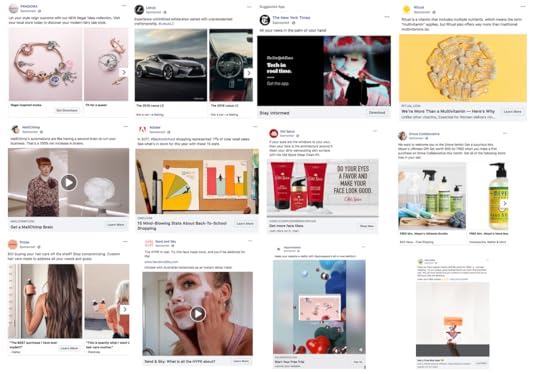 September 18, 2018
September 18, 2018Anna Hubbel, writer at AdvetiseMint, Facebook advertising agency
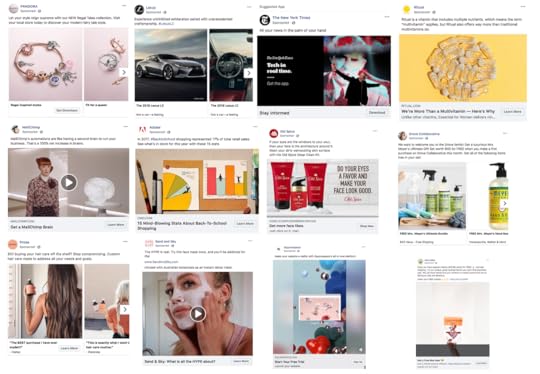
Almost everyone has experienced creative block, even the most talented artists among us. Take Shakespeare who, in Sonnet 86, blames a rival writer for his inability to write. Simply give Gwen Stefani’s song “What You Waiting For” a listen to feel her frustration over her inability to write a hit song.
Creative block is a common occurrence, and you shouldn’t be ashamed of experiencing it. You also shouldn’t be ashamed of finding inspiration from your favorite brands. Here’s a list of 20 Facebook ads from which you can draw inspiration. Why should you emulate these ads? Because they are effective.
1. Sugar Bear Hair
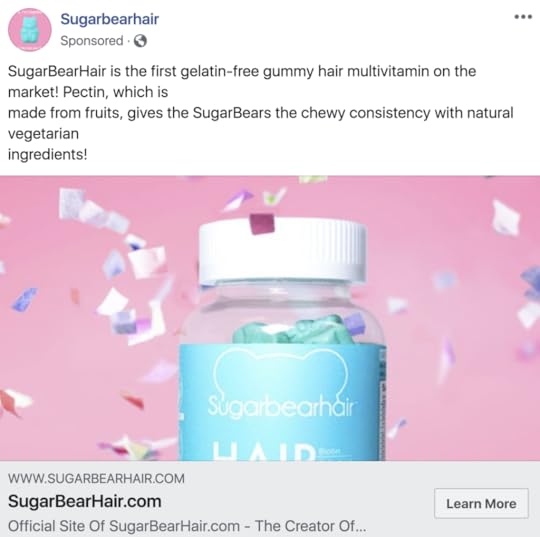
Sugar Bear Hair is a gummy vitamin that helps women grow thicker, healthier hair. This brand’s vibrant ad not only catches your eye but also employs an effective marketing strategy.
The text, instead of pushing for a hard sell, educates audiences about the product. The ad teaches them about the product’s ingredient, pectin, which is “made from fruits” and “gives the SugarBears the chew consistency with natural vegetarian ingredients.” By educating audiences about its product, the ad also simultaneously presents a benefit: the product is all natural and vegetarian.
While teaching audiences about its product, the ad also incorporates branding in the image. Not only does the image feature the product and logo, but it also maintains a color scheme consistent with the brand’s: blue and pink. The colors are bright and eye-catching, popping from the cluttered News Feed.
2. Dollar Shave Club
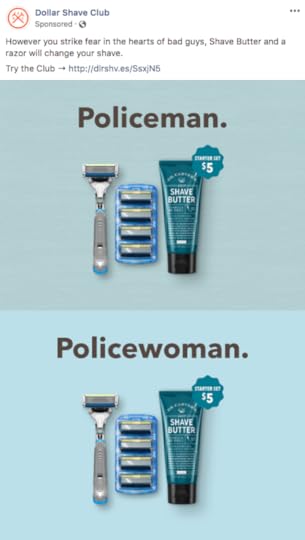
This ad by Dollar Shave Club, a subscription service for razor users, tackles a relevant topic: women’s equality.
The ad evokes emotion by using the strong words and phrases “strike fear,” “hearts,” “bad guys,” and “change.” These words give the audience, especially the women in that audience, a sense of empowerment.
The sense of empowerment plays an important role in the ad’s image. The image address both the policeman and the policewoman and emphasizes the equality between men and women by including identical products with gender-neutral colors and prices under each word. The identical prices reference a common problem women face with razor products: the pink tax. By addressing this issue, the ad positions itself not only as a brand that is aware of social issues but also as a brand that empathizes with women’s plights.
3. NatureBox
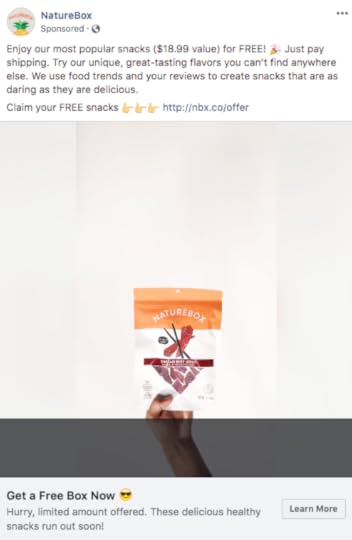
Why is this video ad by Nature Box worthy of emulation? It’s optimized for mobile, it features the product, it uses bright colors, it creates a sense of urgency, and it appeals to people’s sense of taste.
In the post text, Nature Box uses the word “free” to grab the audience’s attention. After all, who doesn’t like free products? The text also appeals to the audience’s sense of taste by using the words “great-tasting flavors” and “delicious.” To make the audience feel the need to try the product, Nature Box uses the words “unique, “can’t find anywhere else,” and “daring.” At the bottom of the ad, Nature Box also creates a sense of urgency by saying “Hurry,” “limited time offer,” and “run out soon!”
Because the ad is in the vertical format, users don’t have to rotate their mobile devices to watch it comfortably. The video’s format, as well as skilled editing, allows the product to be displayed clearly in the video. The bright orange theme, prevalent throughout the ad, is consistent with Nature Box’s brand. Viewers can’t help but feel a little happy while watching the ad.
4. Prose
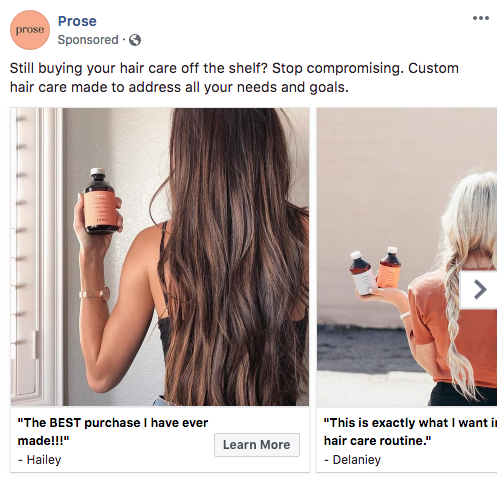
Prose’s Carousel ad illustrates the power of testimonials. In the post text, Prose empathizes with women’s frustration over off-the-shelf hair care products, offering a custom experience that will solve each woman’s hair “needs and goals.” The ad is comprised of carousel cards with different testimonials and images to support the ad’s claim of addressing hair needs. One of the customers in the testimonials raves “The BEST purchase I have ever made!!!”
The branding in this ad is also done well, with the products featured in each image and the color scheme complementing the colors of the product labels. The photos are also high-quality, making Prose look more trustworthy. By using testimonials, consistent branding, and beautiful high-quality images, Prose appeals to every woman’s desire for gorgeous hair.
5. Madison Reed
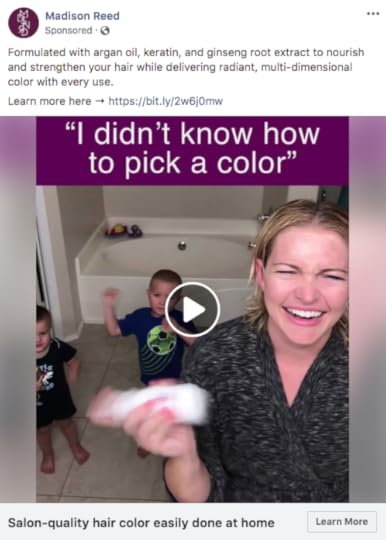
Madison Reed’s ad educates, evokes emotion, and presents a value proposition. It educates in the post text by revealing the ingredients of Madison Reed hair colors: argan oil, keratin, and ginseng root extract. It evokes the desire for beautiful and healthy hair by using the words “nourish,” “strengthen,” “radiant,” and “multi-dimensional” in the post text and “salon-quality” in the text below the ad.
The ad also presents a value proposition by telling its audience the benefits they get when they buy from Madison Reed: beautiful, healthy, salon-quality hair and a coloring system easily done at home. The value proposition is also in the video: it features a woman getting ready to color her hair in her bathroom while her children watch from the background. The value is obvious: the hair color is easy and convenient to use. It appeals to women with hectic lifestyles, women who have limited time or money to spend two hours at a salon.
To ensure the branding is noticeable throughout, this video ad optimized for mobile contains the color purple consistent with Madison Reed’s brand and logo, making the ad pop on users’ phone screens.
6. Sand and Sky
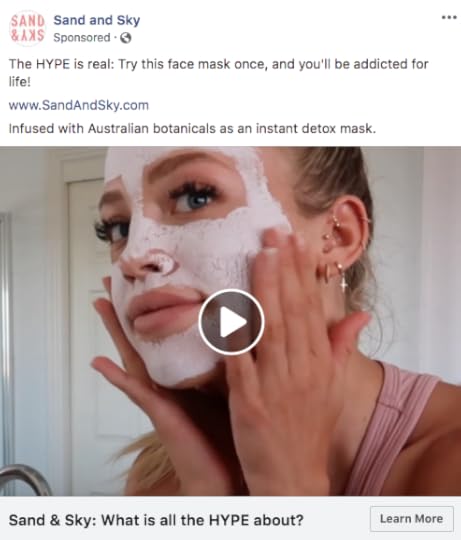
This Sand and Sky video ad both excites and informs its audience. In the post text, the words “hype,” “addicted for life,” and “instant” get the audience excited for the face mask. It also conveys that others have used the product. By creating excitement and buzz around the face masks, the ad entices its audience to watch the video to learn more.
The ad also informs the audience by including a demonstration of the mask. The video shows how it works, featuring both the application and the removal of the mask. As a result, the video allows the audience to see the process from before to after. The value proposition of an instant detox mask further attracts the audience’s attention.
7. Gwynnie Bee
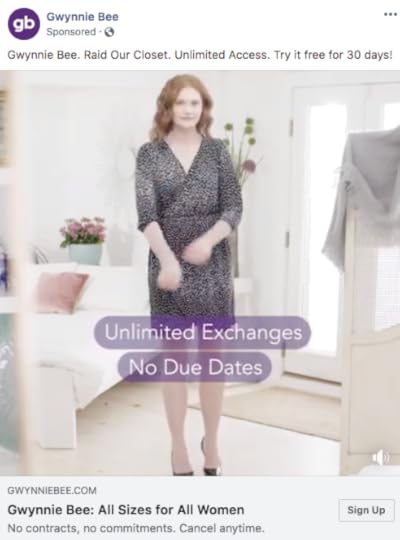
Gwynnie Bee uses value proposition as its primary tactic to promote its clothing subscription service. The vertical ad promotes unlimited exchanges, no due dates, all sizes, a 30-day trial, the ability to cancel anytime, and no contracts or commitments. The ad compliments these offers with a video of a model wearing the various style options the service offers.
To ensure the audience will remember the brand after seeing the ad, the video consistently uses the purple color scheme to match the company’s logo.
8. Old Spice
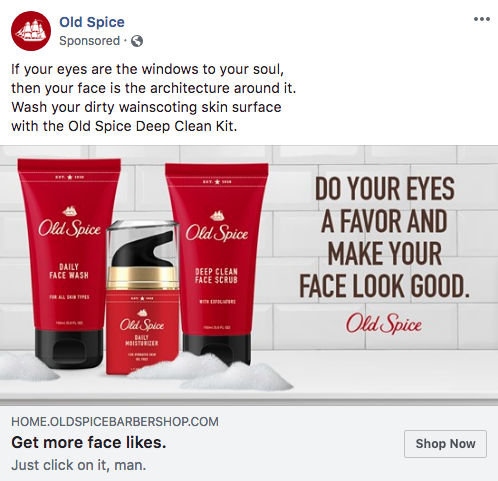
This Old Spice ad, as with most of the company’s marketing, uses humor to spice up users’ feeds. In the post text, Old Spice uses the adage “eyes are the windows to your soul” to convey the humorous idea that because the face is “the architecture around it,” it’s important to keep it clean. The text within the creative gives the humorous punch of “Do Your Eyes a Favor and Make Your Face Look Good” to urge the audience to use Old Spice to keep their faces well kempt. To top it off, the text below the image, “Get more face likes,” offers a silly yet simple value proposition. It tickles the viewer’s funny bone one last time with “Just click on it, man.”
9. Noom
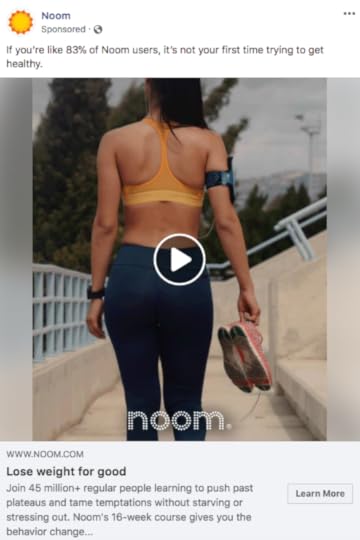
Noom uses video ads like this one to educate and offer benefits to people who want to lose weight. In the post text, Noom uses the words “if you’re like 83% of Noom users ” to show the amount of current Noom users who tried to become healthy. The ad taps into the frustration people feel when finding an effective weight loss system by adding “it’s not your first time trying to get healthy.”
After creating a sense of frustration, Noom positions itself as the answer to its audience’s prayers. Within the video, large text that says “A smarter way to lose weight” appears, making the audience feel like they need to look no further. Noom reinforces this idea within the headline that says “Lose weight for good.” The clear value proposition tells viewers they no longer have to waste time with other weight loss programs.
Noom pairs its rhetorical strategies with branding by featuring a woman wearing an orange sports bra that matches the orange ring in Noom’s logo.
10. Ritual

To capture the audience’s attention, Ritual creates intrigue around its product. “Ritual offers way more than traditional multivitamins do,” says the ad, suggesting that buyers will get health benefits that they can’t get elsewhere. The ad then increases interest. Using the teaser “We’re More Than a Multivitamin — Here’s Why,” Ritual compels the audience to learn more about the product. This ad gives enough information to communicate the main message (we offer more benefits than normal multivitamins) while also leaving the audience wanting to know more.
Ritual also uses the image to capture attention. The yellow background and the vitamins arranged in a circle cleverly complements the circular Ritual logo while placing the product front and center. The ad is simple yet eye-catching enough to attract users.
11. The New York Times
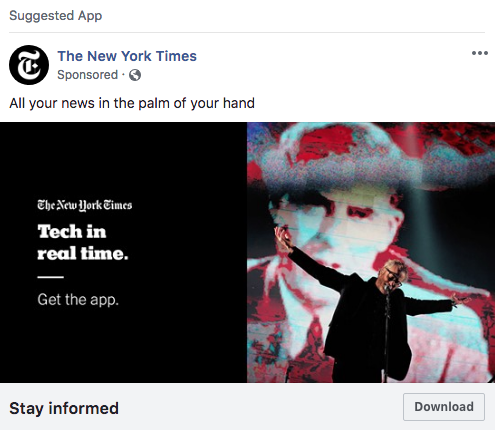
The New York Times markets its app in this simple yet powerful ad. The ad both evokes emotion and offers a value proposition. In very few words, the post text makes its audience feel empowered with “All your news in the palm of your hand.” The ad image offers the value proposition of “Tech in real time,” telling users they’ll get all their news instantly and conveniently from their mobile devices. The Times punctuates the message with “Stay informed” below the ad, directly next to the “Download” call to action.
The ad reinforces branding by using the black-and-white theme of The New York Times. It flows nicely with the image to the right, which depicts a news-like story one might come across in the app.
This ad is especially effective because of its simplicity. All of the text is in short, clear sentences that demonstrate the ease, convenience, and power of the app.
12. Grove Collaborative
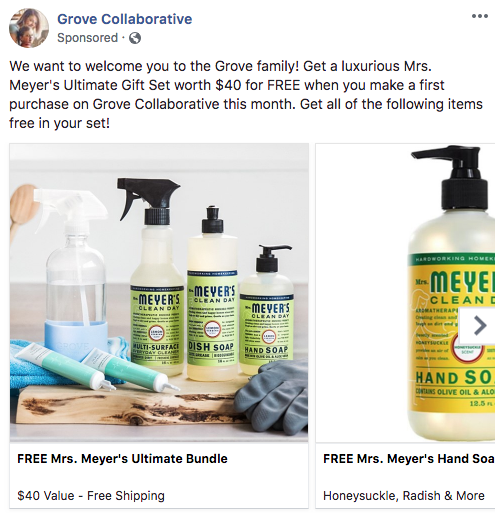
Grove Collaborative uses a Carousel ad to feature its products. The company also liberally uses the word “FREE” to entice shoppers. The images support the benefits described in the text by exhibiting the products buyers can get in their free set. Additionally, the images used in the ad are high-quality photos, making the company appear professional and trustworthy.
13. MailChimp

This MailChimp ad uses high-quality video, value proposition, and humor to drive its message. In the post text, MailChimp conveys the convenience of its marketing email automations by using the humorous comparison of a second brain. According to the ad, signing up for MailChimp is a “100% net increase in brains.” Translation? MailChimp automation is high-tech and intelligent.
Throughout the video, MailChimp uses bright colors to contrast against the white background. The quirky woman who talks rapidly explains the concept of the “second brain,” both informing and entertaining viewers.
14. Bombas
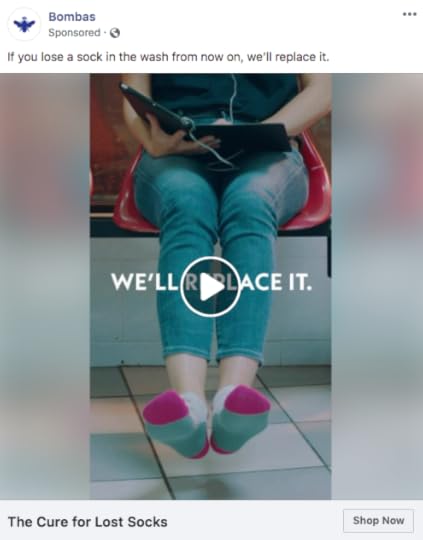
Bombas uses a common dilemma to hook its audience in this ad: a lost sock. Because nearly everyone has lost a sock in the laundry, Bombas offers to replace the socks customers lose. It even uses the headline “The Cure for Lost Socks” to appeal to those who hate losing socks.
15. Home Chef
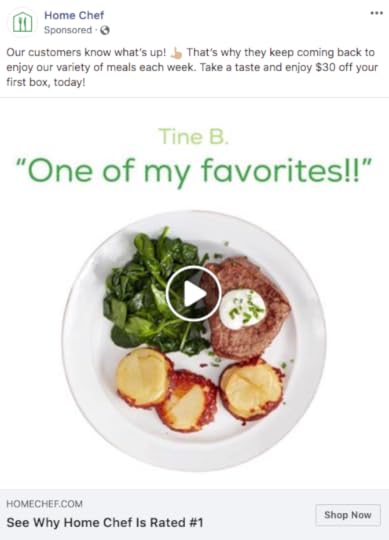
Home Chef highlights customer testimonials in this video ad to build trust and prove that the meal subscription service is rated number one. The post text also offers a discount on the first box, giving users more incentive to buy.
Throughout the video, Home Chef uses upbeat music and high-quality images of delicious food to appeal to its audience’s senses of taste and sound. The color green is also prominent, cohesively matching the green logo on the upper-left corner of the ad.
16. Lexus
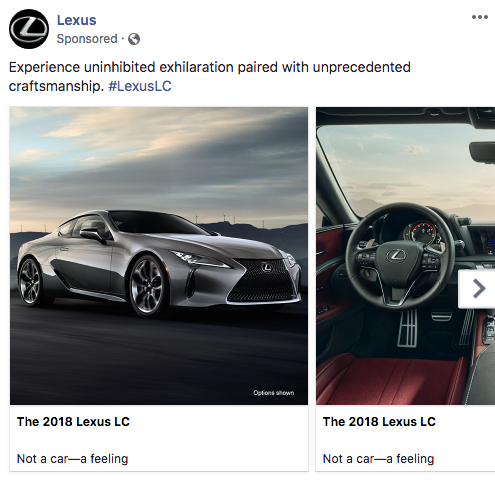
In this Carousel ad promoting the 2018 Lexus LC, the text creates a feeling of adventure and excitement by using the phrase “uninhibited exhilaration.” It then emphasizes that the Lexus LC is more than a product: “Not a car — a feeling.”
To capture attention, the ad features stunning images of the vehicle from both the exterior and the interior, using dramatic lighting and the phrase “unprecedented craftsmanship” to draw attention to quality. The ad’s color scheme, silver and black, as well as the focus on the car with the logo, highlights the Lexus brand.
17. Adobe
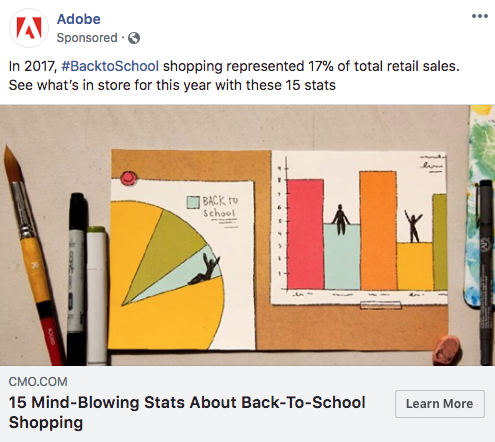
Adobe educates its audience in this back-to-school ad. Using some statistical information from last year’s back-to-school season in the post text, the ad invites the audience to access shopping data for 2018. By offering educational information, Adobe provides a benefit in exchange for customers’ clicks on the ad.
18. Coca-Cola
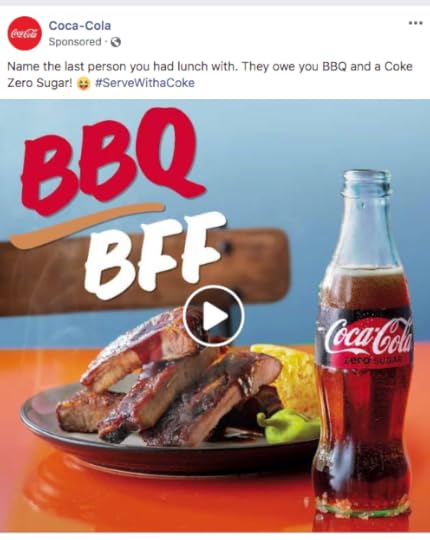
One can’t help but drool when looking at this Coca-Cola ad. The ad appeals to the senses, causing the audience to crave a refreshing bottle of Coke. First, the ad pairs an image of delicious steaming barbeque with a bottle of Coke to appeal to the sense of taste. Then the ad accompanies those images with chatter and clanking plates to appeal to the sense of sound. The colors are also bright, with red appearing throughout the video to match the brand logo.
To increase engagement on the ad, it brings in a social element by playfully encouraging its audience to tag a friend in the comments section: “Name the last person you had lunch with.”
19. Squarespace
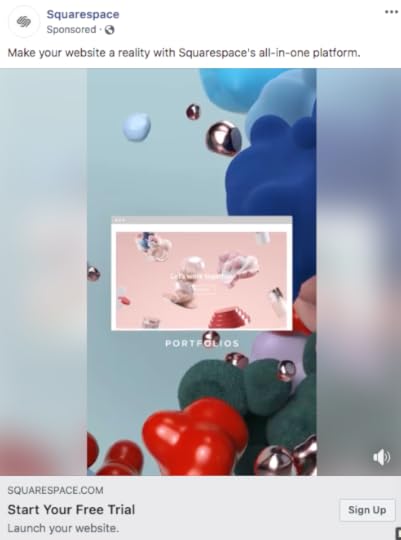
Not only is this Squarespace ad optimized for mobile screens, but it is also simple yet high-tech. First, it offers value proposition by telling its audience that they can “Make their website a reality” with the company’s “all-in-one platform” with its free trial. Second, the video uses bright colors, unique shapes, movement, and upbeat music to demonstrate different tasks that can be done through the platform. The video gets the audience excited about making their website come to life.
20. Pandora
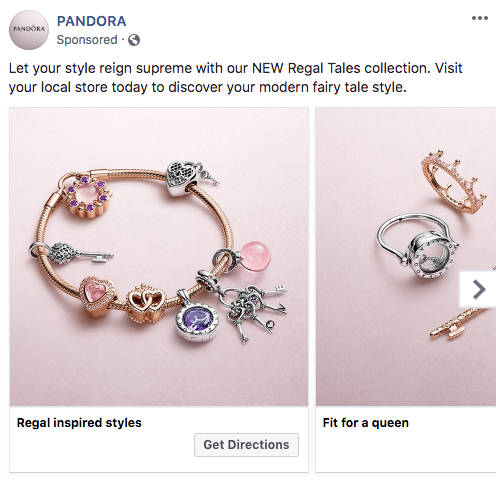
Last but not least, this Carousel ad by Pandora uses high-quality photos with bright colors to evoke emotion. Using words like “regal,” “reign,” “fairy tale,” and “queen,” this ad appeals to the inner princess of its female audience. It elicits the desire to feel pampered and pretty.
Each image features Pandora’s products against a light pink background, matching the background of the brand’s logo. In the last image of the ad, Pandora even presents a map with its location and invites the audience to “Get Directions,” driving foot traffic to physical stores.
There is no shame in looking to popular and successful brands for inspiration. Note the strategies each brand used and apply them to your own ads. If you want to use video like many of these ads, see what expert media buyers suggest in terms of Facebook video best practices.
Written by Anna Hubbel, writer at AdvetiseMint, Facebook advertising agency
The post 20 Facebook Ads and Why They’re So Effective appeared first on AdvertiseMint.
September 12, 2018
When Disasters Like Hurricane Florence Strike, Facebook Can Help
 September 12, 2018
September 12, 2018Anne Felicitas, editor at AdvertiseMint, Facebook ads company
 Nikolas Noonan / Unsplash
Nikolas Noonan / UnsplashEarlier this week distressing news flooded TV and phone screens. This coming Thursday, Hurricane Florence, a category 4 storm, is heading for the Carolinas and the Virginia region. Predicted to be the strongest storm to hit the Carolinas in decades, according to CBS News, Hurricane Florence is sending residents to evacuation.
Evacuation is only one among the many ways the residents are bracing for impact. The residents of North Carolina, according to CBS News, are preparing emergency supplies and equipment, such as chainsaws and bulldozers, for the storm’s aftermath. One tool people seem to overlook in this crisis is, as strange as it may sound, Facebook.
An app that is nearly omnipresent in people’s devices (Facebook has one million downloads in Google Play Store), Facebook has tools people in crises can use to seek help and alert loved-ones of their safety.
Crisis Response
Accessible by clicking the hamburger button on the upper-right side of the Facebook app, Crisis Response is a hub for people in a disaster. Using this tool, people can seek help by commenting on posts and messaging those offering aid. A tool that is several years old, Crisis Response has helped those in need during disastrous events such as the fire in Trabuco Canyon, the flooding in the Philippines, and the fire in Goleta.
When Hurricane Florence hits the targeted states, residents can use Crisis Response to ask for aid, keep up with local news, and alert loved-ones when out of danger.
Safety Check
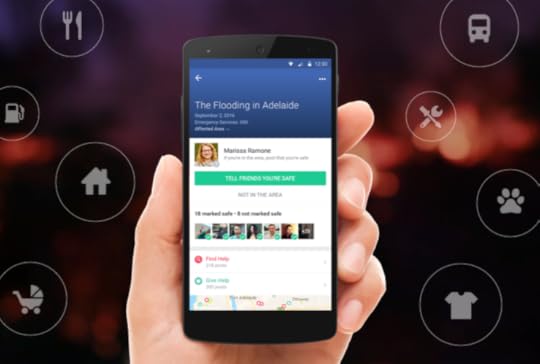 Photo courtesy of newsroom.fb.com
Photo courtesy of newsroom.fb.comA feature of Crisis Response, Safety Check allows people to mark themselves as “safe” on Facebook. When a disastrous event occurs within an individual’s area, whether that disastrous event is an earthquake, mass shooting, or flooding, Facebook will send that individual a notification with the option to “tell friends you’re safe.” Safety Check works by using users’ location listed in their profiles and the location enabled for the app on mobile devices.
Facebook Lite
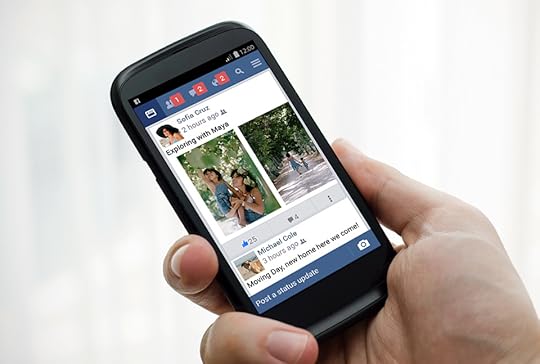 Photo courtesy of newsroom.fb.com
Photo courtesy of newsroom.fb.comFacebook Lite is a lightweight version of the app that uses fewer data and functions normally in areas where network conditions are unreliable. It contains Facebook’s core features, such as the News Feed, status updates, and notifications. Because this version doesn’t use a lot of data, those in disasters can switch to Facebook Lite when the regular app loads too slowly if at all. When a hurricane like Florence hits, it’s important to anticipate low internet connectivity.
Fundraisers
Fundraisers allows users and organization to fundraise for a cause they are passionate about. Currently, notable organizations such as St. Jude’s Children’s Research Hospital, Alzheimer’s Association, and World Wildlife Fund use the tool to fundraise for their causes.
Although only a year old, Fundraisers generated $300 million in donations, 100 percent of which all go to the nonprofits. With such a success, those willing to help victims of disasters can certainly use the tool to fundraise independently or donate to an organization’s fundraiser.
This Thursday, Hurricane Florence will hit the Carolinas and the Virginia region. Although an unconventional tool to use during disasters (normally batteries, first aid kits, food and water supplies, and flashlights are seen as better suited for those events) the Facebook app can help people in need.
Anne Felicitas is the editor of AdvertiseMint, Faebook ads company. You can follow her (@littlebananie) on Instagram.
The post When Disasters Like Hurricane Florence Strike, Facebook Can Help appeared first on AdvertiseMint.
Facebook to Launch Facebook Stories Ads
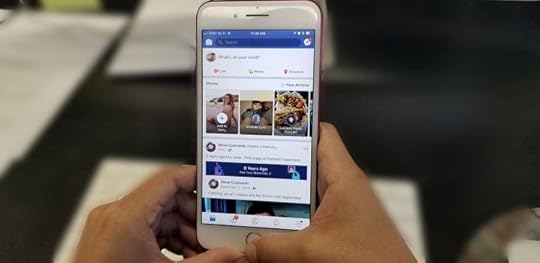 September 12, 2018
September 12, 2018Anna Hubbel, writer at AdvertiseMint, Facebook ads company
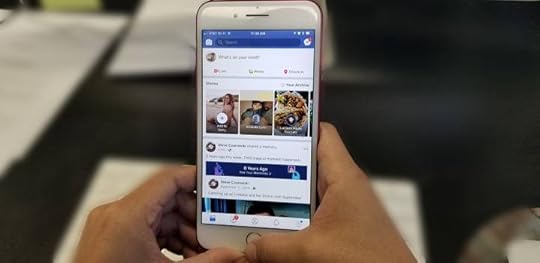
After seeing positive results for Facebook Stories ads, Facebook will soon allow everyone to serve ads to Stories.
Currently still in beta, ads in Facebook Stories are delivering positive results for media agencies, according to Digiday. The feature generates low costs and high engagement, the ideal balance for any social media campaign.
Wallaroo Media, which first began testing the format about a month ago, found that some of its Facebook Stories ads within its $20,000 ad spend have outperformed other ads in other placements.
“CPM and conversion rates have been the best of any placements over the course of the last month, probably due to the fact that the competition is lower there,” Brandon Doyle, founder of Wallaroo, told Digiday.
Digiday reports that ads in Facebooks Stories are expected to roll out globally by the end of the year. As digital media consultant Matt Navarra shared in a tweet, an email directed to Facebook’s marketing partners on September 6 invites advertisers to join the beta test to prep for the global release.
“Your customers have already been able to reach their audience with Instagram Stories ads,” Facebook says in the email, “and now they have another opportunity to reach even more people in this full-screen, vertical environment with Facebook Stories ads.”
Flight-booking service Hopper has seen positive results in its tests with Facebook Stories ads. The company told Digiday that it’s paying $2.3 per thousand impressions with the format, which is less than the $5 per thousand impressions it’s paying for Instagram Stories. For both formats, the company is using similar targeting and creatives, as well as the same time frame. Hopper also told Digiday that the conversion rates from Facebook Stories ads have not been much different than those from Instagram Stories.
As promising as ads in Facebook Stories appear to be so far, there are still some downsides. For one, only 150 million people use Facebook Stories on a daily basis, which is significantly smaller than the userbases of Instagram Stories and Snapchat. Additionally, Facebook Stories ads don’t have the same useful features that Instagram offers, such as links and product tags. However, Facebook will likely introduce such features gradually after rolling out ads in Facebook Stories.
To qualify for the beta test of ads in Facebook Stories, advertisers must also run the same ads in Instagram Stories or Facebook News Feed. This stipulation allows advertisers to compare the results of their Facebook Stories ad campaigns with those of other campaigns on Facebook-owned platforms.
Anna Hubbel is a writer at AdvertiseMint, Facebook ads company
The post Facebook to Launch Facebook Stories Ads appeared first on AdvertiseMint.
Twitter Has a Cool New Audio-Only Feature
 September 12, 2018
September 12, 2018Anna Hubbel
Writer at AdvertiseMint, Facebook ad agency

Say it loud, say it proud! You can now share audio-only broadcasts on Twitter for iOS and Twitter’s Periscope, Tech Crunch recently reported. In the same place where you create a live video, you can create an audio broadcast, providing another option for sharing unique content.
According to Tech Crunch, the audio-only option appears as another button you can tap when you navigate to Live. As you would with live video, you can see metrics such as live viewers, replay viewers, and time watched when making an audio-only broadcast. Although the new feature is only available on iOS and Periscope at this time, it’s sure to roll out to other platforms sometime in the future.
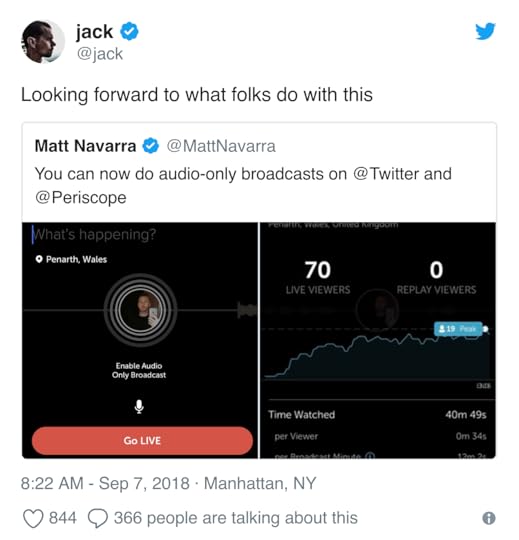
Audio-Only Is Great for the Camera Shy
If you’re like me, and you hate seeing yourself in a video, this audio-only feature is a godsend. Being able to get my message across without feeling squeamish about my appearance is going to be a massive weight off my shoulders in instances where I believe a live broadcast is the more effective option over a regular tweet. Twitter may see a spike in the number of live broadcasts users make with this new feature available because users who don’t typically broadcast because they’re camera shy may feel more comfortable with the sound of their voice.
Twitter’s audio-only broadcast feature may also appeal to the growing podcast audience. People today are flocking to podcasts for interesting and engaging content. Twitter may become a go-to place for podcasts if this audio-only feature takes off.
Let’s not overlook the benefits of being able to share a message in more than 280 characters as well. If you don’t want to spend 10 minutes trying to edit your tweet down to the maximum limit, it’ll be easy to say what you want to say in an audio clip instead.
It’s no surprise that Twitter now has an audio-only broadcast option. Facebook already offers a live audio option, so the concept isn’t revolutionary. However, Twitter’s live audio may be more popular than Facebook’s since Twitter is more of a news-snippet hub, and audio will contribute to that niche.
Anna Hubbel is a writer at AdvertiseMint, Facebook ad agency.
The post Twitter Has a Cool New Audio-Only Feature appeared first on AdvertiseMint.
September 11, 2018
What to Do After Accidentally Liking an Old Instagram Post
 September 11, 2018
September 11, 2018By Anne Felicitas, editor at AdvertseMint, Facebook advertising company

Deny it as vehemently as you want, but you, like many of us with social media accounts and smartphones, are guilty of hardcore Instagram stalking. How could you not when it is so easy? Thanks to social media apps and the Internet, we can broadcast our lives to hundreds by simply posting an image or video to Instagram, a task that is hardly a task at all, considering it takes three seconds to do (more, if your data is slow. Damn you, Sprint).
Like many of us seasoned stalkers with hypersensitive touchscreen phones, you, after scrolling through a decade’s worth of content, accidentally liked an old post by someone whose Instagram account you shouldn’t be stalking, like an ex flame, a current flame’s ex flame, or a crush. What do you do other than wish to pass away? Should you abandon society and run to the mountains, living among your animal friends like a millennial Snow White? From one seasoned stalker to another, here’s what you should do.
Unlike the Post
This is the obvious and easiest solution to your mortifying dilemma. As soon as your finger slips, double tapping the image from five years ago, you must immediately unlike the post to remove the like from the image and the notification from the activity feed. The keyword here is immediately. If you dawdle, you give the person the chance to view Activity, click on your profile, and stalk you. How the tables have turned. Keep in mind, unliking the post does not turn back time and undo the push notification that popped up on the person’s screen once you liked the image.
This solution may not satisfy you. If you want a more drastic approach that doesn’t involve passing away or becoming a mountain man or mountain woman, consider option number two.
Block the Account

It’s sad to part with a beloved account that you can’t help obsessively stalking, but alas, desperate times call for desperate measures.
When you block the account, the like disappears from the image, the notification disappears from Activity, and the person you’re stalking can’t find your account on Search. This solution is the answer to your prayers because it not only erases your mistake, but it also erases you from Instagram. Poof! It’s like the dreadful event never happened. But—and yes, there is a but—this solution is only foolproof if the person didn’t turn on push notifications. Even if you blocked the person, the notification still would have appeared on the person’s phone screen. It’s an unfortunate flaw in the solution, but take comfort in the knowledge that, once clicked, the notification won’t appear in the activity feed.
Take Responsibility

Although not the ideal solution, this is the mature and responsible action of the three. If you accidentally liked a person’s post, you can do nothing. Bravely own up to your mistakes. Humiliation is an uncomfortable emotion, but it isn’t lethal, and it certainly isn’t permanent. In fact, you might forget about the incident a week or two later.
Besides, depending on who you’re stalking, the accidental like may not be such an embarrassing mistake after all. If the person is a crush, then consider it divine intervention. Because you couldn’t make the first move, the universe did it for you. Hopefully the accidental like will blossom into a steamy romance.
If the person you’re stalking is a stranger, then it’s no big deal. In fact, Instagram is a social discovery platform, existing to help you connect with people whose content resonates with you. Why else do people include an excessive number of hashtags on their posts? You guessed it—they want to be discovered. What you see as an embarrassing error may be a show of appreciation and recognition to the person you’re stalking.
Now, if you accidentally liked the post of an ex or your partner’s ex, and you will only take responsibility when LA rent lowers to an affordable price, that’s fine. Unlike the post, block the account, or do both for good measure. You’re only human.
Anne Felicitas is the editor of AdvertiseMint, Faebook advertising company . You can follow her (@littlebananie) on Instagram.
The post What to Do After Accidentally Liking an Old Instagram Post appeared first on AdvertiseMint.
September 7, 2018
The New Amazon Attribution Tool Will Show You Why Amazon Ads Are Better
 September 7, 2018
September 7, 2018Anna Hubbel
AdvertiseMint, Faceebook ad agency

Photo courtesy of stores.org
Amazon is so confident in the success of its ads that it is now testing an attribution pixel that will show advertisers how ads on its sites measure up against those on rival sites. According to Digiday, it is called the Amazon Attribution tool. The test invites only advertisers that sell on Amazon, not through it, according to Digiday.
The Amazon Attribution tool will allegedly help advertisers see just how effective their Amazon campaign is compared to their campaigns on other sites. Since it’s so challenging to achieve high search rankings on Amazon due to the massive competition for top spots, Amazon recognizes that advertisers may give up and take their businesses elsewhere. The company wants to prove that the effort is well worth it by supplying undeniable metrics.
Digiday says some of the conversion metrics advertisers can choose from with the new tool include page views, purchase rate, and sales.
“This move will encourage brands to drive more ads to Amazon because they’ll have attribution parity,” Connor Folley, former Amazon executive and founder of search ad platform Downstream, told Digiday. “Brands will see how much better their Amazon product detail pages convert compared to their own site. From an ROI perspective, they’ll be hard pressed to justify driving traffic elsewhere as a result.”
Digiday points out that Google, up until now, had an advantage over Amazon because it offers attribution for measuring both Google and Amazon campaigns. Amazon releasing its own attribution tool will help build advertiser loyalty.
“Owning your own attribution lets you grade your own homework,” Ben Tregoe, senior vice president of revenue at ad tech company Nanigans, told Digiday. “The reason each platform is intent on having its own attribution system is that they know the other platforms cannot be trusted to properly credit ads outside their own platform. Google is always going to say [its] ads were more effective in driving the conversion just as Facebook and Amazon will.”
Earlier this summer, Amazon also began testing Sponsored Products placement to external sites.
Written by Anna Hubbel, writer at AdvertiseMint, Faceebook ad agency.
The post The New Amazon Attribution Tool Will Show You Why Amazon Ads Are Better appeared first on AdvertiseMint.
A Standalone App for Instagram Shopping Is in the Works
 September 7, 2018
September 7, 2018Anna Hubbel
AdvertiseMint, Facebook ads company

Brooke Cagle / Unsplash
You may soon be able to sell your products in a standalone Instagram app currently in the works. According to The Verge, Instagram is building an app, under the assumed name of IG Shopping, made exclusively for buying products from merchants users follow on Instagram. The app allows customers to buy items directly through it.
Presently, it is unknown when Instagram plans to launch the new app. There’s also the possibility that Instagram may decide not to launch it at all. But The Verge reports it’s very likely that in either case, we will definitely see Instagram “make a major expansion into e-commerce.”
News of this new app should get you excited. As The Verge points out, more than 25 million businesses use Instagram, two million of which are paying advertisers. Additionally, four in every five Instagrammers follow at least one business. With such promising opportunities and successes on an increasingly popular platform, a standalone app dedicated to shopping could be a major breakthrough for businesses.
Instagram and E-Commerce
In October last year, Instagram rolled out the feature Shopping (previously called Shoppable Photo Tags) to thousands of sellers. The feature allows businesses to add tags to products on posts. Shoppers can click the tag and buy the featured product without leaving Instagram. Additionally, Instagram made it possible to sell products in Stories using a similar shopping tag feature.
The new standalone app currently in the works could make it easier for businesses to turn shoppers into loyal customers.
Written by Anna Hubbel, staff writer at AdvertiseMint, Facebook ads company
The post A Standalone App for Instagram Shopping Is in the Works appeared first on AdvertiseMint.
This Brand’s Instagram Marketing Strategies Turned Me into a Loyal Customer
 September 7, 2018
September 7, 2018Anna Hubbel
AdvertiseMint, Facebook advertising company

Charles Deluvio / Unsplash
I’m not going to lie: shopping for a new bra excites me. I could spend hours browsing different styles and materials online. Most of the time, however, I end my search without ever buying anything. Because I suffer from serious buyer’s remorse, I usually talk myself out of purchasing. However, one brand got through to me. I bought my favorite bra from Lively after watching a captivating Instagram ad.
There were a few key reasons I responded to the Lively ad I saw on Instagram. First, the sophisticated color palette caught my eye. As I stopped mid-scroll to examine the ad, the casual tone of voice appealed to me. Reading the caption, the highlighted benefits, testimonials, and offers sealed the deal.
The Sophisticated Color Palette
Every woman has her own color preference when it comes to intimate wear. I for one have never been a huge fan of hot pinks or garishly bright colors. I like the subtle, muted tones of peaches, pinks, greys, and blacks. If you visit Lively’s Instagram profile, you’ll see that the brand not only has products that primarily consist of those colors, but all of its ads and photographs match the colors for one cohesive, stylish palette. Rather than featuring one of the brand’s light pink bras in a photo, Lively also features a model wearing a similarly toned peach robe while holding a glass of pink wine. The photo matches the brand’s style and color palette to reinforce branding.
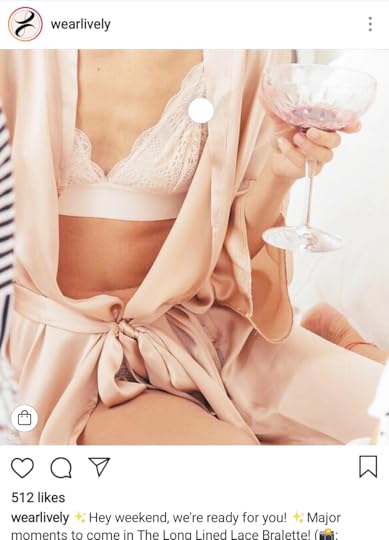
Maintaining a single color scheme isn’t a tactic unique to Lively. In fact, it is a practice many Instagram influencers employ. Among those influencers is fashion and lifestyle blogger Noelle Downing (@noelledowning) who says in an article by Huffington Post that she uses orange and rust tones as her consistent color scheme because they perform better.
“I always really liked warm tones,” Downing said in the article. “For a long time I really loved the color red, and that actually used to be the main focus. Now I’ve moved away from that because I started noticing that, weirdly, when bright red was in a photo, it wasn’t performing as well as the ones that had an overall warm tone instead of one red thing.”
Toronto lifestyle blogger Joelle Anello (@lapetitenoob) also expressed the impact of a consistent color scheme and aesthetic in her success on Instagram in a Page Cloud article. She maintains pink hues and complementary colors across all of her images.
“I make sure to have a similar color palette in all of my photos,” Anello said in the article. “But as well, I take all of my shots in similar lighting conditions.” She added, “Using the same apps and filters to edit all of your photos is important.”
The Highlighted Benefits
I like a nice push-up bra that doesn’t over enhance but gives me just enough umph. Lively’s Instagram ads stood out to me because they highlighted the comfort of their push-up bras without the underwire. To support its claims, Lively’s video ads showed models exhibiting the bra’s astounding results. By clearly highlighting the benefits of the product and demonstrating it in use, the Lively ad got me to stop mid-scroll and visit the online store.
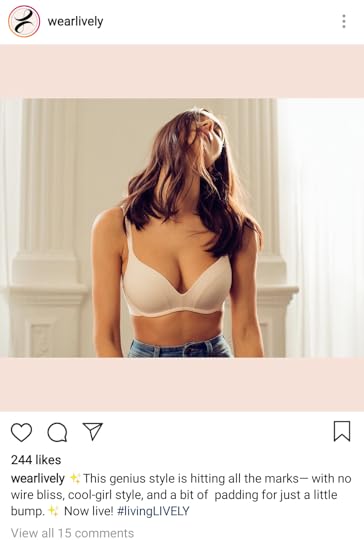
The strategy Lively employed that compelled me to purchase is called value proposition, the benefit Lively’s products give to customers. This strategy appears nearly everywhere. For example, Google uses value proposition when marketing Google Drive to its audience. Its ads state simply “A safe place for all your files,” communicating to customers that they get secure and large storage space when they use Google Drive.
Workplace productivity and messaging app Slack also uses effective value proposition, promising to make “working lives simpler, more pleasant, and more productive.” This kind of marketing message helped the company generate a $3.8 billion valuation. These are only some examples of brands using value proposition to reach its audience.
The Testimonials
Many of Lively’s Instagram ads and posts have captions that include testimonials from real customers that made me feel like I could trust the brand to deliver quality products. After all, people like me bought, tried, and tested the product. If they loved it, so will I. Normally I would research the brand for reviews, but since they are included in the ads and posts, I didn’t need to spend more time doing that. Lively brought that information to me.
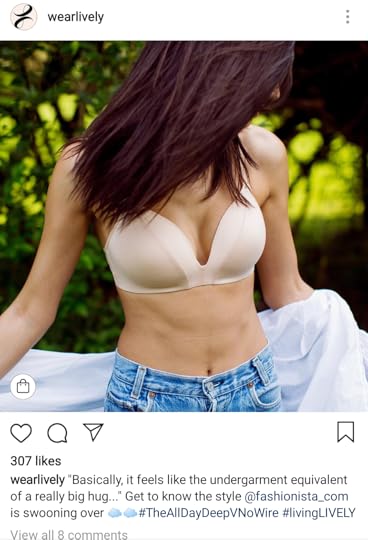
Using testimonials to build trust with potential customers has historically proven to be effective. According to Big Commerce, 92 percent of consumers read online reviews and testimonials to inform their purchase decisions, with 88 percent trusting online reviews just as much as personal recommendations. Big Commerce also provides the following statistics regarding the effects of online testimonials:
Increasing review volume leads to higher conversion rates.
Product-specific review content drives search traffic and keyword rankings, specifically when a business earns 10 or more reviews, resulting in 15 to 20 percent increase in search traffic.
Three- and four-star reviews contain two times as many product suggestions as others.
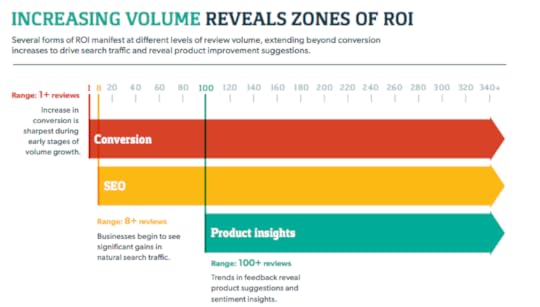
Image Courtesy of Big Commerce
Testimonials are so effective because consumers desire social proof, says Content Marketing Institute.
“Social proof is a psychological phenomenon where people conform to the actions of others under the assumption that those actions are reflective of the correct behavior,” writes Mary Fernandez on Optin Monster’s Conversion Rate Optimization blog. She adds, “In other words, consumers want proof from their peers and unbiased third parties, not the brands selling the products.”
The Promotional Offers
Nothing says “thank you for buying” better than promotional perks. Lively consistently does so through its Instagram ads, making the temptation to purchase even stronger. The brand often offers a free tote bag with every purchase made during a promotional time period. This not only gives buyers extra incentive, but it also creates a sense of urgency.
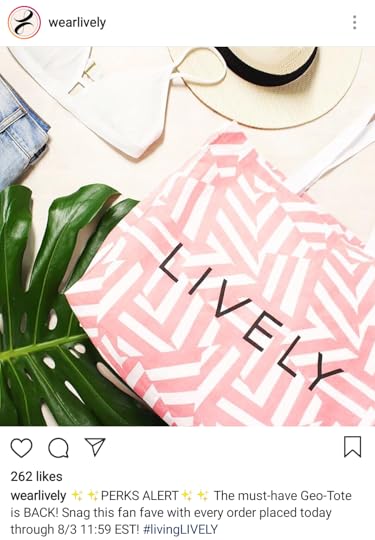
Promotional offers are a hit with customers. Zee Dog, a company that connects dogs and people through its pet products, used Instagram Stories and video ads last year to reach customers during Black Friday. During the second stage of the campaign, the company announced the products that were running out and reminded customers that the Black Friday deals were expiring soon. As a result, Zee Dog more than doubled sales compared to the previous Black Friday season.
“We were able to exceed our revenue target and more than double sales compared to Black Friday 2016, with a lower investment than the previous year, focusing on segmentation and ad formats, which had good performance over the year,” the company stated in its Instagram success story. “This definitely made it the best Black Friday in Zee Dog’s history!”
A Casual Tone of Voice
A casual tone of voice doesn’t work for every brand, but it works for Lively. In many of its Instagram ads, Lively uses bold language that regular people like me can relate to. For example, in one ad, the caption says “Say hello to the series that’s made for doing what you want to and looking damn good doing it.” In addition to being relatable, this tone is empowering and confident, making a shopper like me want to buy a product that makes me feel that way.
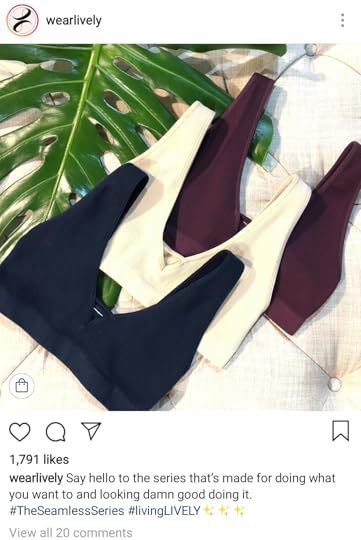
Marketers have found more success in sounding conversational in their social media ads than sounding salesy. According to a Forbes article, being conversational, for example, being humorous, can help differentiate your brand.
“Humor breaks down walls, shows personality, a.k.a. shows a brand’s human side,” Forbes contributing writer Steve Olenski says. He also points out that “Funny brands are more relatable and are seen as more trustworthy and human.”
In other words, the more relatable the tone of voice, the more trustworthy your brand is perceived by your customers.
When my Lively box arrived in the mail, I was giddy with excitement. When I opened it, it didn’t disappoint. It felt carefully arranged just for me, and it exceeded my expectations for quality. Instagram helped Lively build up that excitement to make me a loyal customer from that point on. Through elegant, colorful visuals, clearly stated benefits, upfront testimonials, and a relatable tone of voice that empowers, Lively was able to add another name to its customer list. No buyer’s remorse here!
Written by Anna Hubbel, staff writer at AdvertiseMint, Facebook advertising company
The post This Brand’s Instagram Marketing Strategies Turned Me into a Loyal Customer appeared first on AdvertiseMint.
September 6, 2018
After Investigation, Facebook Removes 652 Pages, Groups, and Accounts
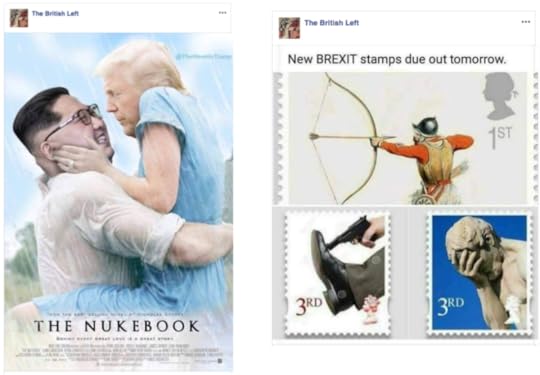 September 6, 2018
September 6, 2018Anne Hubbel
AdvertiseMint, company for Facebook ads

A network of accounts posted political content directed at the UK and the United States
To combat misuse, Facebook removed 652 pages, groups, and accounts. The removed violators exhibited “coordinated inauthentic behavior,” targeting internet users in the Middle East, Latin America, United Kingdom, and the United States. Facebook traced the activity back to Iran.
Cybersecurity firm FireEye gave Facebook a tip back in July about a network of Facebook pages and accounts through other online platforms under the name of Liberty Front Press. Facebook investigated the network and found it linked to Iranian state media using publicly available website registration information. The suspicious network used related IP addresses and Facebook pages with the same admins.
Liberty Front Press’ Suspicious Activities
Created in 2013, the Liberty Front Press accounts kept their location hidden, posting politically divisive content directed at the Middle East, the UK, Latin America, and the United States. The accounts acted as news or civil society organizations, neglecting to disclose their real identities while sharing instigative information. As with the Russian troll accounts that disseminated politically divisive content during the 2016 US presidential election, Facebook saw this type of behavior as misleading and violative.
In the first stage of the investigation, Facebook found that Liberty Front Press had 74 Facebook pages, 70 Facebook accounts, three Facebook groups, and 76 Instagram accounts. Approximately 155,000 accounts followed at least one of those pages, 2,300 accounts joined at least one of those groups, and more than 48,000 accounts followed at least one of the Instagram accounts. Facebook also found that, other than hosting three events, the network actively advertised on the platform. It spent more than $6,000 on Facebook and Instagram ads, paying in US and Australian dollars. The first ad ran in January 2015, the last in August 2018

The network posted content in English
In the second stage, Facebook discovered links between Liberty Front Press and a completely different set of accounts and pages, the first of which were created in 2016. As with the other accounts and pages, they acted as news organizations without disclosing their real identities. Unlike the first set of accounts and pages discovered, however, this set employed cybersecurity attacks and tried to hack users’ accounts.
During its investigation of the second set of accounts and pages, Facebook found 12 Facebook pages, 66 Facebook accounts, and 9 Instagram accounts. Approximately 15,000 accounts followed at least one of those suspicious pages, and more than 1,100 followed at least one of the Instagram accounts. Although Facebook did not find any ads and events by those accounts and pages, Facebook did find posts written in Arabic.

The network also posted content in Arabic
In the third stage of the investigation, Facebook found more accounts and pages dating as far back as 2011. The accounts and pages shared content about politics in the Middle East using Arabic and Farsi and in the UK and United States using English. Facebook first learned about this particular set last year, prompting its expansion of the investigation this summer.
From its third discovery, Facebook found 168 Facebook pages, 140 Facebook accounts, and 31 Instagram accounts. Approximately 813,000 accounts followed at least one of the pages, and more than 10,000 followed of at least one of those Instagram accounts. Additionally, the accounts hosted 25 events.
Facebook also found that the account spent more than $6,000 on Facebook and Instagram ads using US dollars, Turkish lira, and Indian rupees. The first ad ran in July 2012, and the last in April 2018.
Facebook says it screens advertisers to identify their locations and to learn whether they are on the list of sanctioned individuals by the US government.
“Based on what we learn in this investigation and from government officials, we’ll make changes to better detect people who try to evade our sanctions compliance tools and prevent them from advertising,” Nathaniel Gleicher, head of cybersecurity policy, wrote in the update.
Facebook also says investigations are still ongoing. The company has shared its findings with both the US and UK governments, as well as the US Treasury and State Departments.
“We’re working closely with US law enforcement on this investigation, and we appreciate their help,” wrote Gleicher. “These investigations are ongoing, and given the sensitivity, we aren’t sharing more information about what we removed.”
In addition to its efforts to crack down on fake pages and accounts, Facebook has removed pages, groups, and accounts with any links to Russian military intelligence services previously identified by the US government. This particular removal is not linked to the Iran-based activity Facebook uncovered in its investigations. It’s primarily focused on political behaviors in Syria and Ukraine.
Action Against Cyber Threats
In the last part of the update, Facebook emphasized that there is a lot the company has to consider when faced with a cyber threat. Some questions Facebook has to answer include
How active is the threat?
How sophisticated are the actors?
How much harm is being done?
How will the threat play into world events?
“Cyber threats don’t happen in a vacuum. Nor should investigations,” Chad Greene, director of security, shared in the update. “Really understanding the nature of a threat requires understanding how the actors communicate, how they acquire things like hosting and domain registration, and how the threat manifests across other services. To help gather this information, we often share intelligence with other companies once we have a basic grasp of what’s happening. This also lets them better protect their own users.”
Greene added that academic researchers and law enforcement are crucial players whenever Facebook encounters cyber threats. When Facebook discovers a suspicious campaign, Greene says it strives to learn all it can about the extent of the bad actors’ presence on Facebook’s services, their actions, and the actions Facebook can take to deter them.
“When we reach a point where our analysis is turning up little new information, we’ll take down a campaign, knowing that more time is unlikely to bring us more answers,” said Greene. However, Greene added that in some cases, Facebook will refrain from taking action if it feels it may tip off the violator, causing them to alter their behavior accordingly before Facebook can take legal measures.
“After all, the more we know about a threat, the better we’ll be at stopping the same actors from striking again in the future,” explained Greene.
But if Facebook suspects that there is an immediate risk, it will take action as quickly as necessary.
Written by Anna Hubbel, staff writer at AdvertiseMint, company for Facebook ads
The post After Investigation, Facebook Removes 652 Pages, Groups, and Accounts appeared first on AdvertiseMint.
September 5, 2018
Google Introduces New “Ad Strength” Tool for Measuring Effectiveness
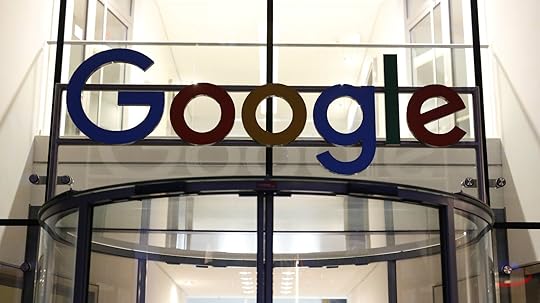 September 5, 2018
September 5, 2018Anna Hubbel
AdvertiseMint, company for Facebook ads

Photo Courtesy of Quartz
Google may have just made A/B testing a whole lot easier. Google’s new “Ad Strength” tool will allow advertisers to measure their ad’s effectiveness before publishing it. Specifically, the new indicator uses a poor to excellent scale to inform advertisers about the strength of their Responsive Search or Display ads.
When measuring your ad’s effectiveness, the Ad Strength tool considers relevance, quantity, and diversity within the ad copy. After detecting the areas where your ad is weak, the tool provides actionable feedback so you can improve your ad before publishing it.
Types of Ad Strength Advice
Google doesn’t do all the work for you and give you every piece of actionable advice possible to make your ad great. If you want the new Ad Strength tool to work well, follow Google’s advice:
Responsive search ads: Provide at least five headlines.
Responsive display ads: Provide up to 15 images and include five logos, headlines, and descriptions per ad.
The rollout of the Ad Strength tool will happen in stages, with a soft introduction when any advertiser writes copy for Responsive Search ads over the next several weeks. You will see Ad Strength as its own column in Google Ads starting early this month. However, you will not yet have access to support help for the new tool until sometime several months from now.
Responsive Search Updates
In addition to the rollout of the Ad Strength tool, Google introduced several updates for Responsive Search ads. First, you can now view ad combination previews as you build an ad. These previews let you see what your ad might look like in various forms, allowing you to browse the top possible combinations. Also, you can now view data for headlines, descriptions, and top combinations in Responsive Search reports, which will help inform you about the type of content that performs best in search results.
Written by Anna Hubbel, staff writer at AdvertiseMint, company for Facebook ads
The post Google Introduces New “Ad Strength” Tool for Measuring Effectiveness appeared first on AdvertiseMint.



